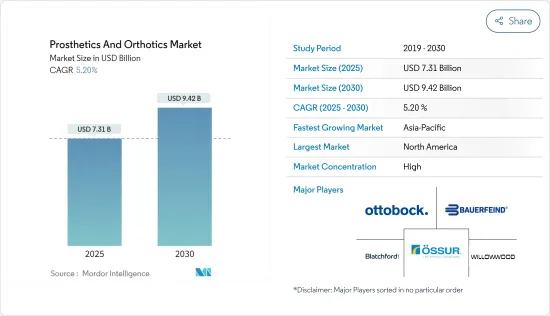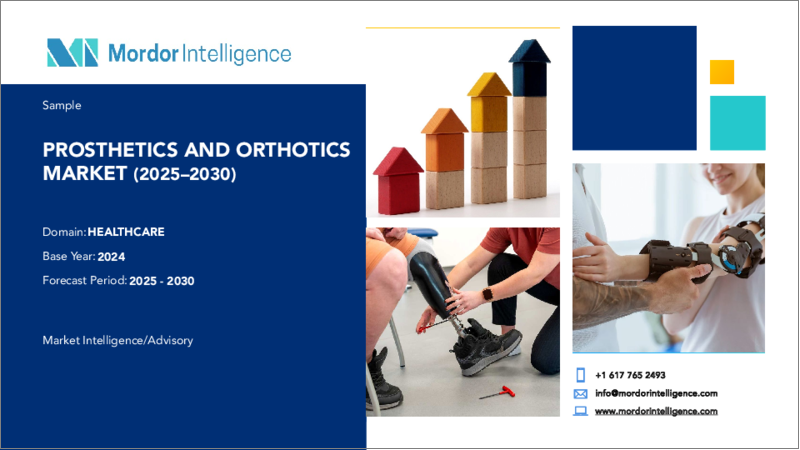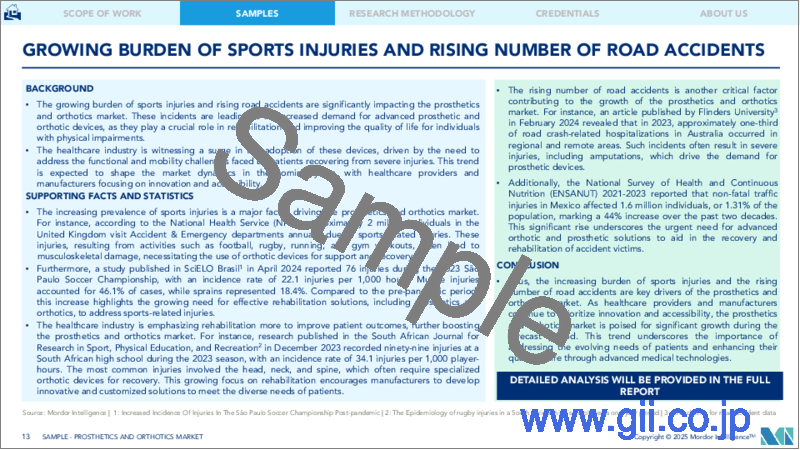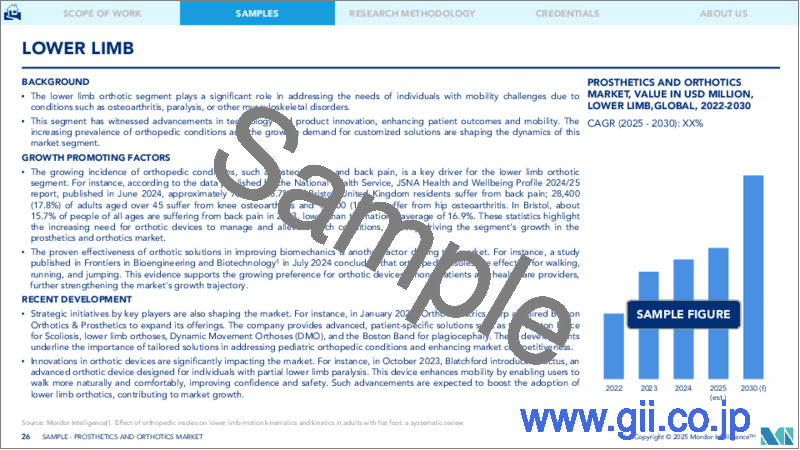|
|
市場調査レポート
商品コード
1692124
義肢および装具:市場シェア分析、産業動向・統計、成長予測(2025年~2030年)Prosthetics And Orthotics - Market Share Analysis, Industry Trends & Statistics, Growth Forecasts (2025 - 2030) |
||||||
カスタマイズ可能
適宜更新あり
|
|||||||
| 義肢および装具:市場シェア分析、産業動向・統計、成長予測(2025年~2030年) |
|
出版日: 2025年03月18日
発行: Mordor Intelligence
ページ情報: 英文 111 Pages
納期: 2~3営業日
|
全表示
- 概要
- 目次
義肢および装具市場規模は2025年に73億1,000万米ドルと推定され、予測期間中(2025~2030年)のCAGRは5.2%で、2030年には94億2,000万米ドルに達すると予測されます。

市場を形成するメガ動向世界の義肢および装具市場規模は、いくつかの主要なメガ動向の影響を受けて大幅な成長を遂げています。これらには、世界人口の高齢化、慢性疾患の増加、生体力学的ソリューションの急速な技術進歩などが含まれます。これらの要因が相まって、革新的な義肢・装具への需要が高まり、継続的な研究開発を促進するエコシステムが形成されています。世界中のヘルスケア・システムは、四肢に障害を持つ人々の生活の質と機能的転帰の改善を優先しており、技術革新の急増とこれらの機器の用途拡大に拍車をかけています。
スポーツ傷害の負担増と交通事故件数の増加:スポーツ関連の負傷者数の増加と交通事故の発生率の増加は、義肢および装具・矯正器具部門にとって重要な促進要因です。スポーツやレクリエーション活動が人気を博すにつれて、軽度の緊張から重度の靭帯損傷に至るまで、スポーツ傷害が顕著に増加しており、しばしば装具によるサポートが必要となっています。同時に、特に開発途上地域での交通事故件数の増加が、補装具に対する大きな需要を生み出しています。この需要は、急性期の介入を促すだけでなく、患者のニーズとともに進化する長期的な補綴ソリューションも育んでいます。
骨肉腫の負担増加:特に小児や若年成人の間で骨肉腫の負担が増加しており、市場の重要な成長要因となっています。この骨肉腫の治療には四肢を温存する手術が頻繁に行われるため、高度な補綴ソリューションが必要となります。補綴技術の革新は、特に若年層の患者にとって、機能性とQOLを向上させながら患者の成長に対応することに重点を置いています。骨肉腫患者特有の要求は義肢および装具デザインの限界を押し広げ、その恩恵はより広い義肢および装具界に及んでいます。
糖尿病による切断の負担増と老年人口の増加:糖尿病に関連する切断の有病率の上昇と世界人口の高齢化は、義肢および装具部門を推進する2つの重要な力です。世界の糖尿病患者の増加に伴い、糖尿病性足潰瘍による下肢切断の発生率が上昇しています。この動向は、義肢および装具に対する継続的な需要を生み出しています。さらに、世界の高齢化により、変形性関節症などの病態に罹患しやすくなっており、装具によるサポートが必要となっています。こうした動向は、高齢者や多様な患者集団の快適性、機能性、使い勝手の向上を目指した義肢および装具技術の革新を促進しています。
義肢および装具市場の動向
下肢義肢:製品情勢を席巻
セグメントの概要:下肢義肢は義肢および装具市場の要であり、市場全体の15.5%を占めています。これは、下肢切断者の運動機能を回復させる上で、義肢および装具が重要な役割を担っていることを反映しています。下肢義肢および装具は、シンプルな膝下義肢からマイクロプロセッサー制御の高度な膝まで幅広く、患者の幅広いニーズに対応しています。
成長の原動力:下肢義肢および装具の需要は、糖尿病関連の切断件数の増加や、血管疾患を患いやすい高齢者人口の増加が後押ししています。また、スポーツ障害や交通事故の増加も市場をさらに拡大させています。軽量素材やスマート義肢などの技術進歩が機能性と快適性を高め、市場の大幅な成長を促進しています。
競合情勢:競争の激しいこの分野では、技術革新が成功のための重要な戦略です。歩行と安定性を向上させる先進的な人工膝関節の開発は、主要な重点分野です。各社はまた、3Dプリンティング技術によるカスタムメイドの人工関節ソリューションも模索しており、個々の患者に合わせた器具を提供しています。市場が成熟するにつれ、義肢および装具とリハビリやデジタルヘルス技術を組み合わせた統合ソリューションへのシフトが予想され、従来の製品モデルがさらに破壊されることになります。
アジア太平洋地域:急成長する地域市場
市場力学:アジア太平洋地域は、世界の義肢・装具市場の中で最も急成長している市場として浮上しており、2024年から2029年までのCAGRは約5.5%と予測されています。中国、日本、インドなどの国々がこの成長を牽引しており、世界の競合情勢を再構築し、北米と欧州の優位に課題しています。
成長の触媒:特に中国と日本では、人口の増加と高齢化が進んでいます。糖尿病などの慢性疾患の有病率の増加、ヘルスケアインフラの整備、医療費の増加が市場成長に寄与しています。ヘルスケアへのアクセスを向上させる政府の取り組みや、義肢・装具のイノベーションに対する認識も需要を押し上げています。
戦略的課題この地域の成長を活用するため、企業はこれらの市場特有のニーズを満たし、コストを削減するための現地生産戦略を採用しています。市場浸透には現地のヘルスケア・プロバイダーとの協力が不可欠であり、価格に敏感な新興国市場で成功するには手頃な価格のハイテク製品が欠かせません。この地域の市場が成熟し続けるにつれて、デジタルヘルス統合と遠隔医療に焦点を当てることが、多様で広大な地域全体で義肢および装具ケアを強化する上で重要な役割を果たすと思われます。
義肢および装具産業の概要
市場の優位性:世界プレーヤーが統合市場をリード
義肢および装具市場は、広範な供給・流通網を持つ少数の世界プレーヤーが支配的であることが特徴です。Ossur社、Ottobock社、Bauerfeind AG社などの主要企業は、複数の地域にわたって確立されたプレゼンスと強力なブランド認知により、大きな市場シェアを占めています。市場は依然として統合されており、限られた有力企業の間で激しい競争が繰り広げられています。
市場リーダー:革新と多角化が成功の原動力
Ossur、Ottobock、Bauerfeind AGのような主要企業は、研究開発と新製品の継続的導入に注力することで優位性を維持しています。例えば、オスルは売上の5%を研究開発に投資し、14の新製品を発表しています。また、上肢・下肢義肢、ライナー、モジュラーコンポーネントなど、患者の幅広いニーズに応える多様な製品ポートフォリオも、市場リーダーの強みとなっています。
将来の成功に向けた戦略技術の進歩と市場拡大
市場シェアを拡大するためには、企業はいくつかの重要な戦略に注力する必要があります。ロボット義肢やスマート装具の開発は、製品の差別化において重要な役割を果たすと予想されます。Ossur社によるNaked Prosthetics社の買収のような戦略的買収も、未開拓市場の開拓に役立ちます。さらに、ヘルスケアのインフラが整備されつつある新興国に注目することで、新たな成長機会が開けると思われます。成功するかどうかは、技術革新、市場拡大、コスト効率のバランスにかかっています。
その他の特典:
- エクセル形式の市場予測(ME)シート
- 3ヵ月間のアナリスト・サポート
目次
第1章 イントロダクション
- 調査の前提条件と市場定義
- 調査範囲
第2章 調査手法
第3章 エグゼクティブサマリー
第4章 市場力学
- 市場概要
- 市場促進要因
- スポーツ傷害の負担増と交通事故の増加
- 骨肉腫の負担増
- 糖尿病関連切断の負担増と老年人口の増加
- 市場抑制要因
- 新興経済諸国および低開発経済諸国におけるヘルスケアインフラの未整備
- デバイスの高コスト
- ポーターのファイブフォース分析
- 新規参入業者の脅威
- 買い手/消費者の交渉力
- 供給企業の交渉力
- 代替品の脅威
- 競争企業間の敵対関係の強さ
第5章 市場セグメンテーション
- 製品別
- 装具
- 上肢
- 下肢
- 脊椎
- 義肢
- 上肢
- 下肢
- ライナー
- ソケット
- モジュラー・コンポーネント
- 装具
- 地域
- 北米
- 米国
- カナダ
- メキシコ
- 欧州
- ドイツ
- 英国
- フランス
- イタリア
- スペイン
- その他欧州
- アジア太平洋
- 中国
- 日本
- インド
- オーストラリア
- 韓国
- その他アジア太平洋地域
- 中東・アフリカ
- GCC
- 南アフリカ
- その他中東とアフリカ
- 南米
- ブラジル
- アルゼンチン
- その他南米
- 北米
第6章 競合情勢
- 企業プロファイル
- Ability Matters Group
- Steeper Inc.
- Blatchford Limited
- Fillauer LLC
- Ossur
- Ottobock
- WillowWood Global LLC
- Ultraflex Systems
- Aether Biomedical
- Bauerfeind AG
- THUASNE
- Mobius Bionics
第7章 市場機会と今後の動向
The Prosthetics And Orthotics Market size is estimated at USD 7.31 billion in 2025, and is expected to reach USD 9.42 billion by 2030, at a CAGR of 5.2% during the forecast period (2025-2030).

Megatrends Shaping the Market: The global Prosthetics and Orthotics Market size is undergoing substantial growth, influenced by several key megatrends. These include the aging global population, rising incidences of chronic diseases, and rapid technological advancements in biomechanical solutions. Together, these factors are driving an increased demand for innovative prosthetic and orthotic devices, creating an ecosystem that fosters continuous research and development. Healthcare systems across the globe are prioritizing improved quality of life and functional outcomes for individuals with limb impairments, fueling a surge in technological innovations and expanding applications for these devices.
Growing Burden of Sports Injuries and Rising Number of Road Accidents: The rising number of sports-related injuries and the growing incidence of road accidents are critical drivers for the Prosthetics and Orthotics sector. As sports and recreational activities gain popularity, there has been a notable increase in athletic injuries, from minor strains to severe ligament damage, often necessitating orthotic support. Simultaneously, the rising number of road accidents, especially in developing regions, has created significant demand for prosthetic devices. This demand not only drives acute interventions but also fosters long-term prosthetic solutions that evolve with patient needs.
Increasing Burden of Osteosarcoma: The rising burden of osteosarcoma, especially among pediatric and young adult populations, is becoming an essential growth driver for the market. Management of this bone cancer frequently involves limb-sparing surgeries, which require advanced prosthetic solutions. Innovations in prosthetic technology are focusing on accommodating patient growth while enhancing functionality and quality of life, particularly for younger patients. The unique demands of osteosarcoma patients are pushing the boundaries of prosthetic design, with benefits extending to the broader prosthetics community.
Growing Burden of Diabetes-related Amputations and Rising Geriatric Population: The escalating prevalence of diabetes-related amputations and the aging global population are two key forces propelling the Prosthetics and Orthotics sector. With the increase in global diabetes cases, the incidence of lower limb amputations due to diabetic foot ulcers is rising. This trend has created a continuous demand for prosthetic devices. Furthermore, the world's aging population is increasingly prone to conditions such as osteoarthritis, necessitating orthotic support. These trends are driving innovation in prosthetic and orthotic technologies, aimed at improving comfort, functionality, and user-friendliness for older adults and diverse patient populations.
Prosthetics and Orthotics Market Trends
Lower Extremity Prosthetics: Dominating the Product Landscape
Segment Overview: Lower extremity prosthetics form the cornerstone of the prosthetic devices market, representing 15.5% of the total market size. This reflects the critical role of these devices in restoring mobility for individuals with lower limb amputations. The range of lower limb prosthetics spans from simple below-knee prosthetics to sophisticated microprocessor-controlled knees, addressing a wide spectrum of patient needs.
Growth Drivers: The demand for lower limb prosthetics is fueled by the growing number of diabetes-related amputations and the increasing elderly population prone to vascular diseases. Additionally, the rise in sports injuries and road accidents further expands the market. Technological advances such as lightweight materials and smart prosthetics are enhancing functionality and comfort, driving significant market growth.
Competitive Landscape: In this competitive segment, innovation is a key strategy for success. The development of advanced prosthetic knees that improve gait and stability is a major area of focus. Companies are also exploring custom prosthetic solutions through 3D printing technology, providing tailored devices for individual patients. As the market matures, a shift toward integrated solutions that combine prosthetics with rehabilitation and digital health technologies is expected, further disrupting traditional product models.
Asia-Pacific: The Fastest-Growing Regional Market
Market Dynamics: Asia-Pacific is emerging as the fastest-growing market in the global prosthetics and orthotics landscape, with a projected CAGR of nearly 5.5% from 2024 to 2029. Countries like China, Japan, and India are driving this growth, which is reshaping the global competitive landscape and challenging the dominance of North America and Europe.
Growth Catalysts: Several factors are driving the rapid expansion in Asia-Pacific, including a large and aging population, particularly in China and Japan. The increasing prevalence of chronic conditions such as diabetes, improved healthcare infrastructure, and rising healthcare spending are contributing to market growth. Government initiatives to enhance healthcare accessibility and awareness of prosthetic and orthotic innovations are also boosting demand.
Strategic Imperatives: To capitalize on the growth in this region, companies are adopting localized production strategies to meet the specific needs of these markets and reduce costs. Collaborations with local healthcare providers are vital for market penetration, while affordable, high-tech products are crucial for success in price-sensitive developing markets. As the region's market continues to mature, a focus on digital health integration and telemedicine will likely play a crucial role in enhancing prosthetic care across diverse and expansive geographies.
Prosthetics and Orthotics Industry Overview
Market Dominance: Global Players Lead a Consolidated Market
The Prosthetics and Orthotics Market is characterized by the dominance of a few global players with extensive supply and distribution networks. Key companies such as Ossur, Ottobock, and Bauerfeind AG hold a significant market share due to their established presence across multiple regions and strong brand recognition. The market remains consolidated, with intense competition among a limited number of prominent companies.
Market Leaders: Innovation and Diversification Drive Success
Leading companies like Ossur, Ottobock, and Bauerfeind AG have maintained their dominance through a strong focus on research and development and the continuous introduction of new products. For instance, Ossur has invested 5% of its sales into R&D, resulting in the launch of 14 new products. Market leaders also benefit from diversified product portfolios that cater to a wide range of patient needs, including upper and lower extremity prosthetics, liners, and modular components.
Strategies for Future Success: Technological Advancements and Market Expansion
To gain a larger market share, companies must focus on several critical strategies. The development of robotic prosthetics and smart orthotic devices is expected to play a significant role in product differentiation. Strategic acquisitions, such as Ossur's purchase of Naked Prosthetics, can also help companies tap into underserved markets. Additionally, focusing on emerging economies with improving healthcare infrastructure will open up new growth opportunities. Success will depend on a balance between technological innovation, market expansion, and cost-efficiency.
Additional Benefits:
- The market estimate (ME) sheet in Excel format
- 3 months of analyst support
TABLE OF CONTENTS
1 INTRODUCTION
- 1.1 Study Assumptions and Market Definition
- 1.2 Scope of the Study
2 RESEARCH METHODOLOGY
3 EXECUTIVE SUMMARY
4 MARKET DYNAMICS
- 4.1 Market Overview
- 4.2 Market Drivers
- 4.2.1 Growing Burden of Sports Injuries and Rising Number of Road Accidents
- 4.2.2 Increasing Burden of Osteosarcoma
- 4.2.3 Growing Burden of Diabetes-related Amputations and Rising Geriatric Population
- 4.3 Market Restraints
- 4.3.1 Lack of Developed Healthcare Infrastructure in Developing and Underdeveloped Economies
- 4.3.2 High Cost of Devices
- 4.4 Porter's Five Forces Analysis
- 4.4.1 Threat of New Entrants
- 4.4.2 Bargaining Power of Buyers/Consumers
- 4.4.3 Bargaining Power of Suppliers
- 4.4.4 Threat of Substitute Products
- 4.4.5 Intensity of Competitive Rivalry
5 MARKET SEGMENTATION (Market Size by Value - USD)
- 5.1 By Product
- 5.1.1 Orthotic Products
- 5.1.1.1 Upper Limb
- 5.1.1.2 Lower Limb
- 5.1.1.3 Spinal
- 5.1.2 Prosthetic Products
- 5.1.2.1 Upper Extremity
- 5.1.2.2 Lower Extremity
- 5.1.2.3 Liners
- 5.1.2.4 Sockets
- 5.1.2.5 Modular Components
- 5.1.1 Orthotic Products
- 5.2 Geography
- 5.2.1 North America
- 5.2.1.1 United States
- 5.2.1.2 Canada
- 5.2.1.3 Mexico
- 5.2.2 Europe
- 5.2.2.1 Germany
- 5.2.2.2 United Kingdom
- 5.2.2.3 France
- 5.2.2.4 Italy
- 5.2.2.5 Spain
- 5.2.2.6 Rest of Europe
- 5.2.3 Asia-Pacific
- 5.2.3.1 China
- 5.2.3.2 Japan
- 5.2.3.3 India
- 5.2.3.4 Australia
- 5.2.3.5 South Korea
- 5.2.3.6 Rest of Asia-Pacific
- 5.2.4 Middle East and Africa
- 5.2.4.1 GCC
- 5.2.4.2 South Africa
- 5.2.4.3 Rest of Middle East and Africa
- 5.2.5 South America
- 5.2.5.1 Brazil
- 5.2.5.2 Argentina
- 5.2.5.3 Rest of South America
- 5.2.1 North America
6 COMPETITIVE LANDSCAPE
- 6.1 Company Profiles
- 6.1.1 Ability Matters Group
- 6.1.2 Steeper Inc.
- 6.1.3 Blatchford Limited
- 6.1.4 Fillauer LLC
- 6.1.5 Ossur
- 6.1.6 Ottobock
- 6.1.7 WillowWood Global LLC
- 6.1.8 Ultraflex Systems
- 6.1.9 Aether Biomedical
- 6.1.10 Bauerfeind AG
- 6.1.11 THUASNE
- 6.1.12 Mobius Bionics






